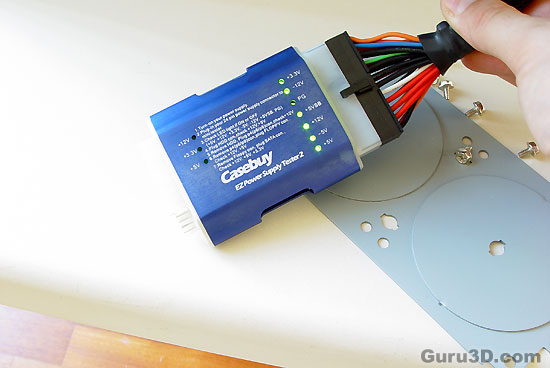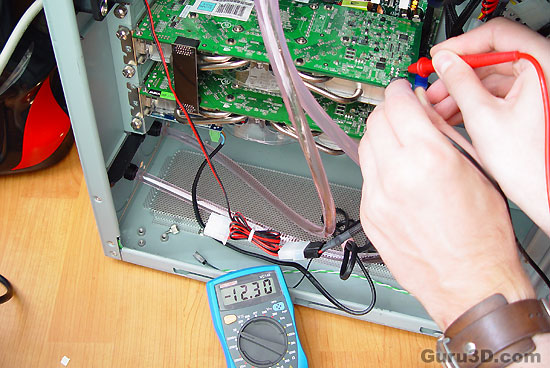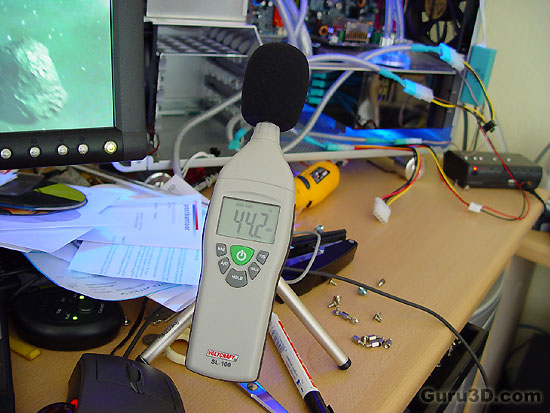Page 6
The Test.
Right, how do you test a PSU ? It's not that difficult actually. We always settle for real-world experiences.
First off before connecting it we test it with this little PSU tester to see if all rails are working properly.

No problem .. all lines are active and functional. Tome to hook up the PSU into a test rig.
This time we took a high-end system and load it up with a lot of tasks. We took an ASUS P5N32 SE DeLuxe mainboard and equipped it with Conroe dual-core E6800 Extreme Processor, 2x GeForce 7900 GTX 512MB, 2 GB DDR2 memory @ 800 MHz, added a DVD-Writer and two HD's.
After the installation we load of ForceWare 91.37 Quad SLI drivers, and enable a seriously funky gaming experience at a monitor resolution of 2560x1600 pixels.
Pretty spiffy setup don't you think ?
Now for the test we loop some gaming timedemo's for a while and monitor the behavior of the PSU. During that process, as we always do, we actually dared and burnt a DVD in the background. Sounds silly ? Not really ...
So what we now do is carefully tap the power distribution lines with a multimeter to see what the fluctuations are like.

Here we tap the 12V2 rails while the system was hard at work. Don't try this at home folks. Do it wrong and you'll blow something up. Tapping it with a mutli-meter will show stability in Watts. Here we see the 12 volts line when the system is in high load.
At one point we also burned a DVD in the background as that requires a stable power supply. Okay you get the idea already, stable as a rock and all that without any additional sound from a fan. Pretty "energetic" stuff.
The fluctuation measures were really small.
| PSU | LOW | HIGH |
| +3.33 IDLE | 3,31 | 3,33 |
| +3.33 LOAD | 3,29 | 3,35 |
| +5.00 IDLE | 5,00 | 5,04 |
| +5.00 LOAD | 5,04 | 5,05 |
| +12.00 IDLE | 12,2 | 12,16 |
| +12.00 LOAD | 12,2 | 12,3 |
Here we took some of the voltages in both IDLE and LOAD (fully utilized) modes. We noted down the lowest and highest value we see and that is the fluctuation. If a PSU is unstable we'd see much fluctuation, differences and discrepancies which can result in system instability.
LOW is the lowest measured value and HIGH of course the highest peak we measured. A 5% fluctuation is perfectly acceptable, it's in fact the ATX standard. So 12 Volts should remain between 11.4 - 12.6v which it is and this system is stressing the PSU heavily.
The PSU remained stable and within the 5% stability rule.
Now then, you've had a peek at the photo's, combined all factors, and now you should have a pretty broad idea of how this PSU would function for your current or future PC. Quite honestly, I did my best. In a 3D intensive test run with 100% utilization in an overclocked environment with at one point even DVD burning in the background. This little toddler is stable for sure, and remember this was tested on a high-end SLI system.
Sound (or the lack of it) - As usual we grabbed our DBa meter, enabled the PSU by hotwiring it and started to listen if it made any significant noise. Short and simple .. the PSU is less audible than the surround noise of the room. It was making less than 30 DBa .. and thus we could not measure it precisely.
The human hearing system has different sensitivities at different frequencies. This means that the perception of noise is not at all equal at every frequency. Noise with significant measured levels (in dB) at high or low frequencies will not be as annoying as it would be when its energy is concentrated in the middle frequencies. In other words, the measured noise levels in dB will not reflect the actual human perception of the loudness of the noise. That's why we measure the dBa level. A specific circuit is added to the sound level meter to correct its reading in regard to this concept. This reading is the noise level in dBA. The letter A is added to indicate the correction that was made in the measurement.
|
TYPICAL SOUND LEVELS | ||
|
Jet takeoff (200 feet) |
120 dBA |
|
|
Construction Site |
110 dBA |
Intolerable |
|
Shout (5 feet) |
100 dBA |
|
|
Heavy truck (50 feet) |
90 dBA |
Very noisy |
|
Urban street |
80 dBA |
|
|
Automobile interior |
70 dBA |
Noisy |
|
Normal conversation (3 feet) |
60 dBA |
|
|
Office, classroom |
50 dBA |
Moderate |
|
Living room |
40 dBA |
|
|
Bedroom at night |
30 dBA |
Quiet |
|
Broadcast studio |
20 dBA |
|
|
Rustling leaves |
10 dBA |
Barely audible |
 An example of how we measure sound-levels in the Guru3D lab. This is not a photo of the PSU being tested btw !
An example of how we measure sound-levels in the Guru3D lab. This is not a photo of the PSU being tested btw !
All in all, very silent and thus highly recommended to any of the audiophiles that like silence (yours truly included).
